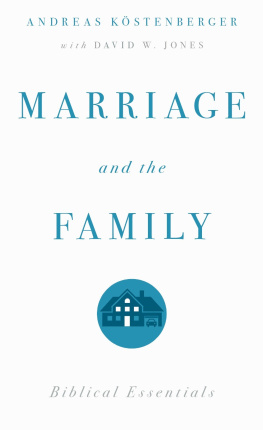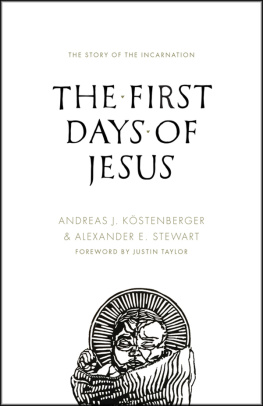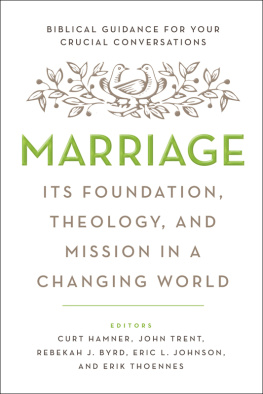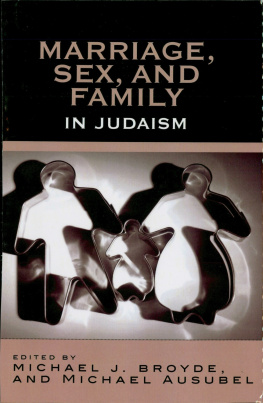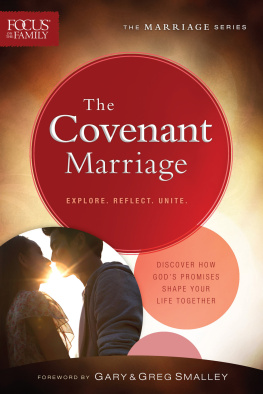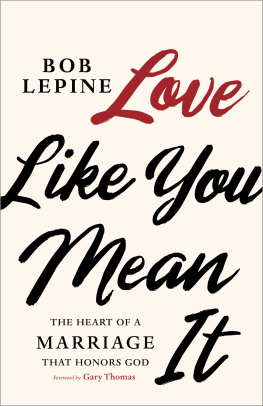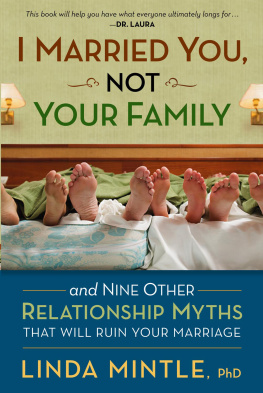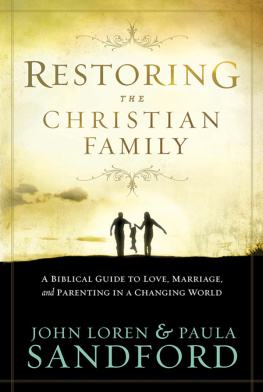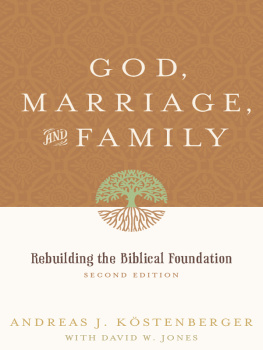What is Gods plan for marriage? There is considerable confusion in contemporary culture regarding the nature of marriage. Only by returning to the biblical foundation for marriage and the family will we be able to rediscover Gods good and perfect plan for humanity in this all-important area of our lives. In this chapter, we will survey all the major biblical passages regarding marriage in both Testaments.
MARRIAGE IN THE OLD TESTAMENT
Rooted in Creation (Genesis 13)
In exploring the biblical teaching on marriage, there is no more important paradigm than Gods intended pattern for marriage presented in Genesis 13. Although Genesis was originally addressed to Israels wilderness generation in preparation for entering the Promised Land, the early chapters of this book provide the parameters of the Creators design for marriage in every age. This is reflected in Jesuss and Pauls teaching and applies to our own age as well. Who is this God who had saved Israel from slavery in Egypt and had given the nation the law at Sinai? What are the foundational teachings on the family, societal structures, and sin?
The first three chapters of Genesis provide answers to these questions, initially from the vantage point of ancient Israel, but ultimately for every person who ever lived. In Genesis 13, the God whom Israel had come to know as Redeemer and Lawgiver is revealed as the Creator of the universe, the all-powerful, all-wise, and eternal God who spoke everything there is into being. Marriage is shown to be rooted in Gods creative act of making humanity in his image as male and female. Sin is depicted as the result of humanitys rebellion against the Creator at the instigation of Satan, himself a fallen creature, and as becoming so much a part of the human nature that people ever since the fall are by nature rebelling against their Creator and his plan for their lives.
The depiction of the original creation of man and woman and the subsequent fall of humanity in Genesis 13 centers on at least three very important clusters of principles: (1) the man and the woman are created in Gods image to rule the earth for God ; (2) the man is created first and is given ultimate responsibility for the marriage relationship , while the woman is placed alongside the man as his suitable helper; and (3) the fall of humanity entails negative consequences for both the man and the woman.
Created in Gods Image to Rule the Earth for God
The fact that both men and women are created in the likeness and image of their Creator invests them with inestimable worth, dignity, and significance. Gods image in the man and the woman has frequently been identified as conveying their possession of intelligence, a will, or emotions. While this may be implied to some extent in Genesis 1:27, the immediate context develops the notion of the divine image in the man and the woman as indicating representative rule (see Ps. 8:68). This rule is the joint function of the man and the woman (note the plural pronouns in Gen. 1:28), although the man carries ultimate responsibility before God as the head of the woman.
Theologians have identified two aspects of the divine image in man: a substantive aspect (that is, an analogy between the nature of God and characteristics of humans), and a functional aspect (humans exercising the function of ruling the earth for God). While a substantive element cannot be ruled out, the functional component seems to reflect most accurately the emphasis in the biblical record. This follows from the immediate context of Genesis 1:27, where creation is defined in terms of being fruitful and multiplying and subduing the earth (Gen. 1:28). The first man and the first woman were thus charged to exercise representative rule in part by procreation .
In this sense, then, human beings are like God. Just as God rules over a large domainthe whole universeso humanity is given charge of the entire earth to rule it for God. This also establishes the principle of stewardship : God, not the man and the woman, is ultimately owner of the created realm; the man and the woman are simply the divinely appointed caretakers. Moreover, this stewardship is a joint stewardship shared by the man and the woman. Together they are to exercise it according to the will and for the glory of God. Together they are to multiply and be stewards of the children God will give them. And together they are to subdue the earth by a division of labor that assigns to the man the primary responsibility to provide for his wife and children, and to the woman the care for and nurture of her family.
The Mans Ultimate Responsibility for the Marriage and the Wifes Role as His Suitable Helper
The apostle Pauls comments on Genesis 13 repeatedly root the mans primary responsibility in both the family and the church in the fact that he was created first . Not only does Paul draw attention to the fact that the man was created first, but he also points out that it is not the man who was made for the woman, but the woman for the man (1 Cor. 11:9; see Gen. 2:18, 20) and from the man (1 Cor. 11:8, 12; see Gen. 2:22). Moreover, the man was the one who received the divine command (Gen. 2:1617), was presented with the woman (Gen. 2:22), and named the woman with a name derived from his own (Gen. 2:23; see 3:20), which also implies his authority.
While Genesis 1 simply notes the creation of man as male and female in Gods image, Genesis 2 provides further detail on the exact order and orientation of the creation of man and woman. At the beginning of human history, God made the first man, endowed him with life, and placed him in a garden (Gen. 2:78, 15). Moreover, God addressed to the man certain moral commands (Gen. 2:1617). Prior to the creation of the woman, the man had already begun exercising the divine mandate to subdue the earth, by naming the animals (Gen. 2:1920). In order to supply his need for companionship, God created the woman to be Adam s wife.
Gods creation of Eve demonstrates that his plan for Adams marriage, and all subsequent marriages, involves a monogamous heterosexual relationship. God only made one helper for Adam, and she was female . What is more, it was God who perceived Adams aloneness and created the woman. The biblical text gives no indication that Adam was even conscious of being alone. Rather, God takes the initiative in fashioning a compatible human companion for the man. For this reason we can confidently say that marriage is Gods idea and that it was God who made the woman as a suitable helper for the man (Gen. 2:18, NIV ).
But what is the force of the expression suitable helper? On the one hand, the woman is congenial to the man in a way that none of the animals are (Gen. 2:1920; she is bone of [his] bones and flesh of [his] flesh, Gen. 2:23); on the other hand, she is placed alongside the man as his associate or assistant . On a personal level, she will provide for the mans need for companionship (Gen. 2:18). In relation to Gods mandate for humanity to be fruitful and multiply and to fill the earth and subdue it (Gen. 1:28), the woman is a suitable partner both in procreation (becoming one flesh with him, Gen. 2:24) and in the earths domestication (Gen. 1:28). Her role is distinct from the mans, yet unique and exceedingly significant. While assigned to the man as his helper and thus placed under his overall charge, the woman is his partner in ruling the earth for God.
There are, however, those who would blur the biblical roles of man and woman, or deny the wifes subordination. Yet nowhere is the man called the womans helper. Thus equality and distinctness, complementarity and submission/authority must be held in fine balance. The man and the woman are jointly charged with ruling the earth representatively for God, yet they are not to do so as unisex creatures, but each as fulfilling their God-ordained, gender-specific roles. In fact, since these functional differences are part of the Creators design, it is only when men and women embrace their God-ordained roles that they will be truly fulfilled and Gods creational wisdom will be fully displayed and exalted.
Next page
